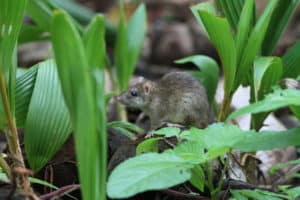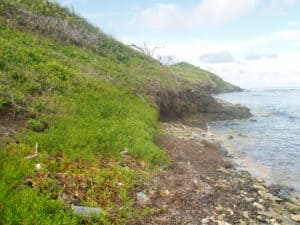Share this article
Rats borne by hurricanes threaten endangered island lizards
Sudden infestations of rats on small Caribbean islands caused by massive hurricanes are threatening fragile island wildlife populations.
These invasive rats could wipe out populations of an endangered species of lizard in the U.S. Virgin Islands — the St. Croix ground lizard (Ameiva polops) — without ongoing monitoring and action by wildlife managers, especially as hurricanes become more frequent.
Recently wildlife managers found that when hurricanes Irma and Maria struck the Virgin Islands weeks apart in 2017, they caused an infestation of black rats (Rattus rattus) at the Green Cay National Wildlife Refuge, located on a small island off the coast of St. Croix.

Black rats invaded a small island off the coast of St. Croix Island after tropical hurricanes. ©Scott Vogt
“After the hurricane, there were rats established on an island where they were absent prior to the hurricanes,” said Aaron Shiels a research scientist with the United States Department of Agriculture’s Animal and Plant Health Inspection Service and the lead author of a study published recently in Global Ecology and Conservation.
How the rats got to Green Cay isn’t clear, Shiels said, but they likely rafted on debris or swam from the main island of St. Croix, which has urban areas and marinas where rats are abundant. St. Croix lies just 1,500 feet from the cay.
Shiels and his co-authors surveyed several protected areas in and around St. Croix for rats before the tropical storms, then set out to do the same after the storms blew through to see how ecosystems and invasive species might be impacted.
They used traps and baited tracking tunnels, which use ink cards that record the prints of the animals that walk across them, at Green Cay, Sandy Point National Wildlife Refuge and Buck Island Reef National Monument.
All of these areas have populations of vulnerable species. The St. Croix ground lizard is found only on Green Cay and Buck Island. Sandy Point and Buck Island have high densities of leatherback (Dermochelys coriacea), hawksbill (Eretmochelys imbricata) and green turtles (Chelonia mydas).

The shoreline of Green Cay National Wildlife Refuge. ©Buck Island Reef National Monument staff
The researchers found that black rats invaded Green Cay, while house mice (Mus musculus) increased in numbers at Buck Island and Sandy Point. The rats prey on young lizards and eggs, and perhaps even adults. The effect of the mice is unclear.
Managers with APHIS and U.S. Fish and Wildlife Service teamed and got to work eradicating the black rats using toxic bait.
This isn’t the first time wildlife managers have removed rats from the area. Several years before the hurricane, a previous population of rats had also been eradicated. And Shiels said it’s possible it won’t be the last.
“It’s likely in the future, especially because we have more hurricanes coming through this region, that we’ll have to do this again,” Shiels said. “With global climate change, the frequency of these large storms is increasing and they’re projected to continue increasing into the future.”
Not all of the hurricanes’ impacts were bad, though. The researchers also found that the storms led to a decrease in invasive mongoose (Herpestes auropunctatus), which prey on turtle eggs, at Sandy Point. These discoveries show that more research needs to be conducted on the secondary effects hurricanes have on wildlife populations, he said.
Header Image: Endangered St. Croix ground lizards live only on two small islands off the coast of St. Croix. Invasive rats eat their eggs and young and possibly adults as well. ©Buck Island Reef National Monument staff








